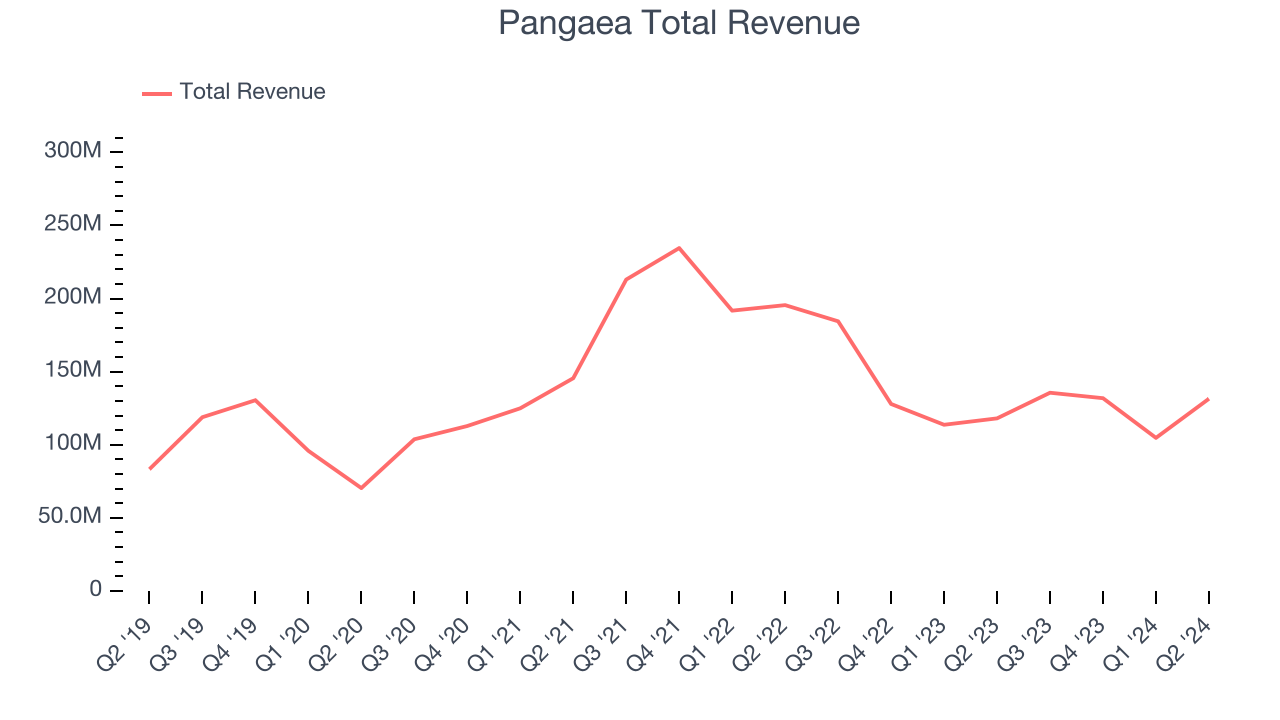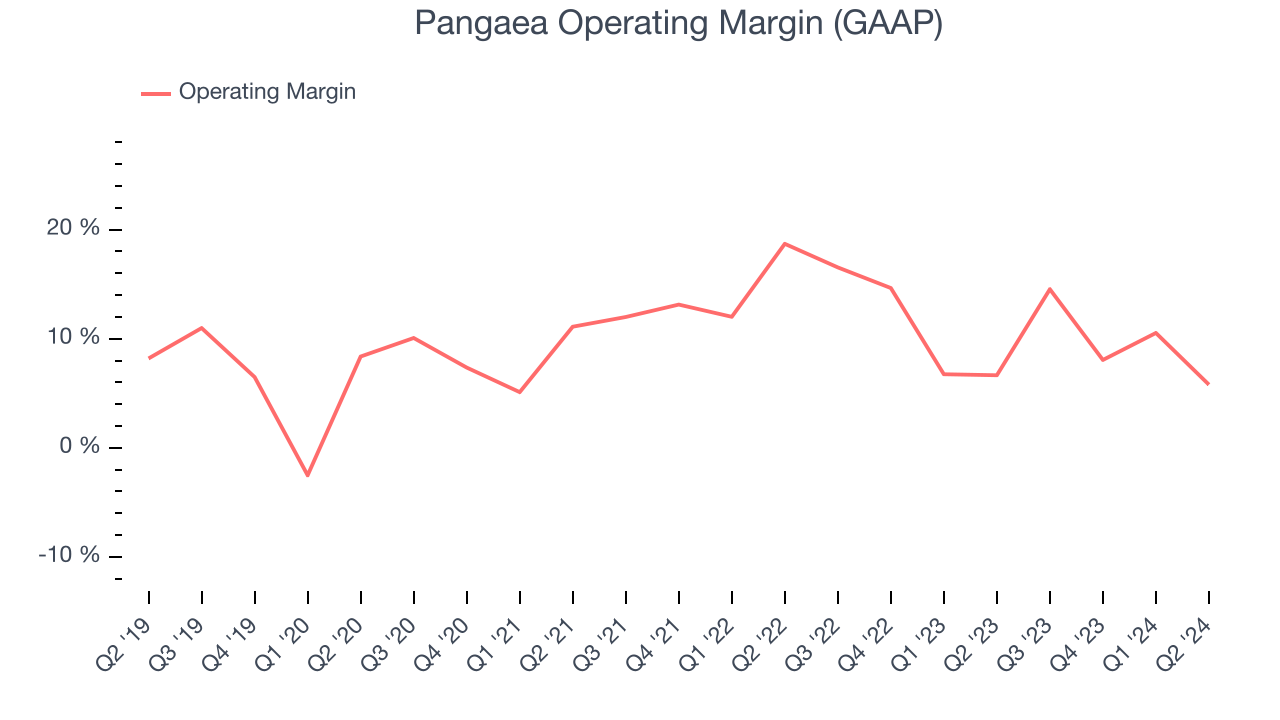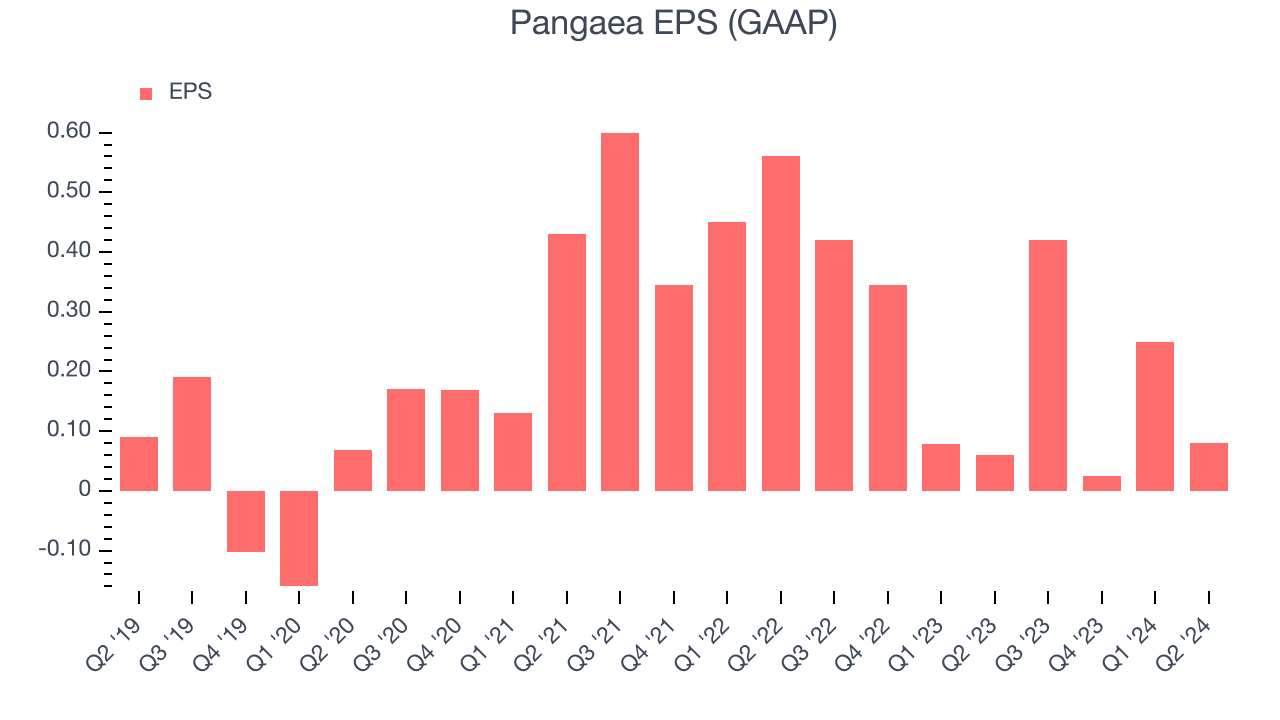Pangaea Logistics (NASDAQ:PANL) reported Q2 CY2024 results beating Wall Street analysts' expectations, with revenue up 11.4% year on year to $131.5 million. It made a GAAP profit of $0.08 per share, improving from its profit of $0.06 per share in the same quarter last year.
Is now the time to buy Pangaea? Find out by accessing our full research report, it's free.
Pangaea (PANL) Q2 CY2024 Highlights:
- Revenue: $131.5 million vs analyst estimates of $112.4 million (17% beat)
- EPS: $0.08 vs analyst estimates of $0.05 ($0.03 beat)
- Gross Margin (GAAP): 15.3%, down from 17.7% in the same quarter last year
- EBITDA Margin: 12.1%, in line with the same quarter last year
- Free Cash Flow of $8.66 million, similar to the previous quarter
- Market Capitalization: $304.4 million
"Our second quarter results reflect consistent execution amid a stable dry-bulk market, which enabled us to deliver continued premium TCE returns," stated Mark Filanowski, Chief Executive Officer of Pangaea Logistics Solutions.
Established in 1996, Pangaea Logistics (NASDAQ:PANL) specializes in global logistics and transportation services, focusing on the shipment of dry bulk cargoes.
Marine Transportation
The growth of e-commerce and global trade continues to drive demand for shipping services, presenting opportunities for marine transportation companies. While ocean freight is more fuel efficient and therefore cheaper than its air and ground counterparts, it results in slower delivery times, presenting a trade off. To improve transit speeds, the industry continues to invest in digitization to optimize fleets and routes. However, marine transportation companies are still at the whim of economic cycles. Consumer spending, for example, can greatly impact the demand for these companies’ offerings while fuel costs can influence profit margins. Geopolitical tensions can also affect access to trade routes, and if certain countries are banned from using passageways like the Panama Canal, costs can spiral out of control.
Sales Growth
A company’s long-term performance can give signals about its business quality. Even a bad business can shine for one or two quarters, but a top-tier one tends to grow for years. Over the last five years, Pangaea grew its sales at a mediocre 6.8% compounded annual growth rate. This shows it couldn't expand in any major way and is a tough starting point for our analysis. 
Long-term growth is the most important, but within industrials, a half-decade historical view may miss new industry trends or demand cycles. Pangaea's history shows it grew in the past but relinquished its gains over the last two years, as its revenue fell by 22.3% annually. Pangaea isn't alone in its struggles as the Marine Transportation industry experienced a cyclical downturn, with many similar businesses seeing lower sales at this time.
This quarter, Pangaea reported robust year-on-year revenue growth of 11.4%, and its $131.5 million of revenue exceeded Wall Street's estimates by 17%. We also like to judge companies based on their projected revenue growth, but not enough Wall Street analysts cover the company for it to have reliable consensus estimates.
When a company has more cash than it knows what to do with, buying back its own shares can make a lot of sense–as long as the price is right. Luckily, we’ve found one, a low-priced stock that is gushing free cash flow AND buying back shares. Click here to claim your Special Free Report on a fallen angel growth story that is already recovering from a setback.
Operating Margin
Operating margin is an important measure of profitability as it shows the portion of revenue left after accounting for all core expenses–everything from the cost of goods sold to advertising and wages. It's also useful for comparing profitability across companies with different levels of debt and tax rates because it excludes interest and taxes.
Pangaea has managed its expenses well over the last five years. It demonstrated solid profitability for an industrials business, producing an average operating margin of 10.6%. This result was particularly impressive because of its low gross margin, which is mostly a factor of what it sells and takes huge shifts to move meaningfully. Companies have more control over their operating margins, and it's a show of well-managed operations if they're high when gross margins are low.
Looking at the trend in its profitability, Pangaea's annual operating margin rose by 3.7 percentage points over the last five years, showing its efficiency has improved.

This quarter, Pangaea generated an operating profit margin of 5.8%, in line with the same quarter last year. This indicates the company's cost structure has recently been stable.
EPS
We track the long-term growth in earnings per share (EPS) for the same reason as long-term revenue growth. Compared to revenue, however, EPS highlights whether a company's growth was profitable.
Pangaea's EPS grew at a spectacular 16.9% compounded annual growth rate over the last five years, higher than its 6.8% annualized revenue growth. This tells us the company became more profitable as it expanded.

Diving into the nuances of Pangaea's earnings can give us a better understanding of its performance. As we mentioned earlier, Pangaea's operating margin was flat this quarter but expanded by 3.7 percentage points over the last five years. This was the most relevant factor (aside from the revenue impact) behind its higher earnings; taxes and interest expenses can also affect EPS but don't tell us as much about a company's fundamentals.
Like with revenue, we also analyze EPS over a shorter period to see if we are missing a change in the business. For Pangaea, its two-year annual EPS declines of 37% show its recent history was to blame for its underperformance over the last five years. We hope Pangaea can return to earnings growth in the future.
In Q2, Pangaea reported EPS at $0.08, up from $0.06 in the same quarter last year. This print easily cleared analysts' estimates, and shareholders should be content with the results. We also like to analyze expected EPS growth based on Wall Street analysts' consensus projections, but there is insufficient data.
Key Takeaways from Pangaea's Q2 Results
We were impressed by how significantly Pangaea blew past analysts' EPS expectations this quarter. We were also excited its revenue outperformed Wall Street's estimates. Zooming out, we think this was a good quarter with some key areas of upside. The stock remained flat at $6.54 immediately following the results.
So should you invest in Pangaea right now? When making that decision, it's important to consider its valuation, business qualities, as well as what has happened in the latest quarter. We cover that in our actionable full research report which you can read here, it's free.
